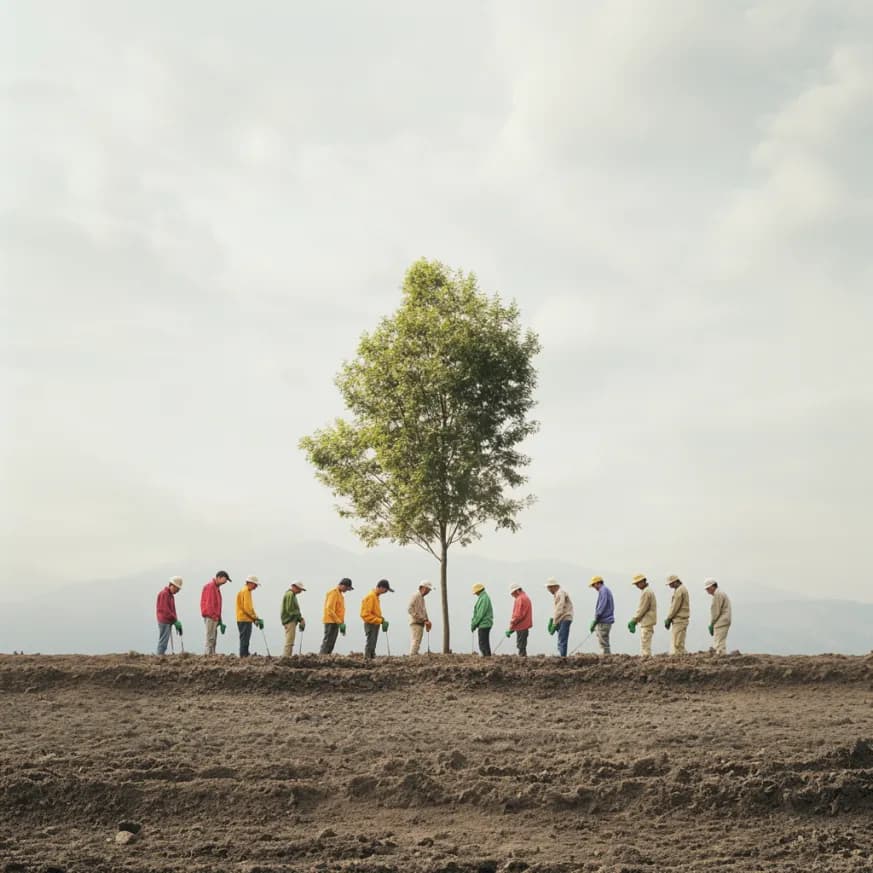This is what happens when every person plants a tree
In the column series “What the world would look like if...”, Elcke Vels explores intriguing scenarios that deviate from the status quo.
Published on May 3, 2025

Our DATA+ expert, Elcke Vels, explores AI, cyber security, and Dutch innovation. Her "What if..." column imagines bold scenarios beyond the norm.
Tropical rainforests, the dark pine forests of Scandinavia—just the thought of a group of trees together makes me happy. I love nature intensely. Since I've been living in a village in Gelderland, you can find me every day in the forest around the corner.
However, trees and plants are not only beautiful; they are vital. They store CO₂, slow down climate change, and provide oxygen. What's more, the ingredients for many medicines come from the rainforest.
I think we should be a little more grateful. Every second, 169 trees disappear. Every second! It's as if we want to get rid of them.
Meanwhile, the human population continues to grow. Every second, approximately 4.3 babies are born worldwide. In total, there are more than 8 billion people living on Earth. That's a lot of people. So I was thinking. What if we joined forces? What if... everyone on Earth planted a tree at the same time? What would happen? Would we give the lungs of our planet a big boost?
8 billion more trees
On a set day, everyone on Earth plants a tree at the same time. The date is announced years in advance, so no one can say it came as a surprise. No excuses—unless you're in the hospital, for example. In that case, you would get a few extra months to plant your tree. And if it really isn't possible, a family member could take over the honor. Don't have a garden? That's no excuse! Special public planting sites would be set up all over the world. It would become a global ritual—one day, one action. Suddenly, there would be 8 billion more trees on Earth.
An unrealistic but educational scenario
Okay, so the plan is clear. Eight billion people are going to plant a tree at the same time. It's a wonderful idea, but of course not entirely realistic. You're not going to get every die-hard nature hater to voluntarily put a seed in the ground. And let's be honest: some people are forgetful, others are just chaotic, and some simply don't feel like it. What's more, even if we do manage to plant eight billion trees, not every seed will actually sprout. All kinds of things will go wrong, of course: the soil will be too dry or too wet, the trees will be planted incorrectly or eaten by animals. But even an unrealistic scenario can be instructive. So let's pretend for a moment: eight billion trees, neatly planted.
Different tree species
Which tree species? That has also been thought through. A fixed list has been compiled for each country with tree species that are suitable for the local climate, soil, and biodiversity. Only trees from that list may be planted, so that the project strengthens nature rather than disrupting it. Do you live in the Netherlands? Then you plant an oak tree, for example. Do you live in Bangladesh? Then you are more likely to choose a mango tree.
CO₂ storage and climate change
It took some hard work. The planning was challenging, and some people were literally at loggerheads. But we did it! And the result? Overwhelming. Each tree can absorb an average of 20 kilograms of CO₂ per year. That means an annual absorption of around 160 billion kilograms of CO₂—a serious blow to global warming. We've all done a great job.
Biodiversity and animal life
Trees are more than CO₂ sponges: they form entire ecosystems. By planting 8 billion trees, we have created millions of hectares of new habitat for animals. Birds, insects, mammals – they all benefit from new shelters, food sources, and nesting places. In tropical areas, lost life is returning. In urban environments, we are seeing bees and butterflies return.
Heat mitigation and livability
We ourselves can also benefit greatly from these green giants. In a world that is getting warmer, trees are natural air conditioners. They provide shade, evaporate water through their leaves, and thus lower the temperature. In cities, it can be up to 7 degrees cooler under a tree on hot days. Planting trees on a large scale has therefore made streets, parks, and villages much more livable—especially during heat waves.
A drop in the ocean
International Tree Planting Day is a great idea, if you ask me. But unfortunately, it's a drop in the ocean. Imagine if everyone in the US, and that's a lot of people, planted one tree every year. After 20 years, when those trees are fully grown, they would only offset about 3% of the carbon dioxide they produce annually.
It's just a suggestion, but maybe it's time to not only join forces to plant trees, but also to work together to ensure that we simply emit less CO₂ into the air in the first place. Fortunately, we are already well on our way in Europe. Let's keep it up!

What if...
In the column series “What the world would look like if...”, Elcke Vels explores intriguing scenarios that deviate from the status quo.
